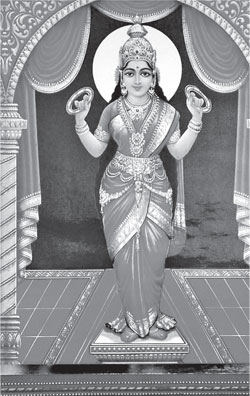Epic Cilappathikaram and Pattini Devi worship
by Nagalingam Kumarakuruparan
The introduction of the Pattini cult by Gajabahu II into Sri Lanka is
not a myth.
The Rajavali states that Gajabahu brought from the Chola country of
South India, the foot ornaments (Anklet) of Pattini Devi, the arms of
the four gods and the patra dhatu of the Buddha which had been taken
away during the time of former king.
 The
statement of Rajavali provides confirmation of the account given by the
Cilappathikaram (Epic of Anklet) that King Gajabahu introduced Pattini
Devi (Kannagi) worship into Sri Lanka. The
statement of Rajavali provides confirmation of the account given by the
Cilappathikaram (Epic of Anklet) that King Gajabahu introduced Pattini
Devi (Kannagi) worship into Sri Lanka.
Though the epic Cilappathikaram might have been produced at a later
date, the statement contained in it regarding the institution of the
Pattini cult pertain to post Sangham period that is in the 2nd or 3rd
century AD.
Festival
As is well known Gajabahu instituted a festival in honour of Pattini
Devi including processions along the streets on Mondays in the month of
Adi (July-August).
It was believed that the worship of the Goddess would dispel all ills
and misfortune.
The facts suggest that religious ideas of the time in Sri Lanka were
not radically different from those in South India.
Bhikkhus Buddhaghosa, Dharmapala, Buddhadutta, Anuruddha and Kasyapa
had visited Sri Lanka from South India.
Antiquity of the Karthikeya or Muruga worship at Kataragama is well
known. King Dutugemunu of old made several endowments to Kataragama.
Cillapathikaram (the story of the Anklet) popularly known as Cillampu
(Anklet) is not only one of the five great epics in Tamil literature but
also the first epic in Tamil
Brilliance
After the lyrical brilliance of the Sangam Age, Epic Age was ushered
in Tamil literature by Jains and Buddhists.
Tradition speaks of the five great epics of which first to be written
was Cilapathikaram.
The epic in Indian literary tradition should contain moral and
spiritual truths. The preface to this work speaks about three spiritual
truths:
Destiny will manifest itself and be fulfilled (Karma or Fate is
continuous and inexorable)
It is natural for great men to adore a chaste lady of great fame or a
woman of chastity is holy; even Gods respect her.
Dharma will become the God of Death to kings who swerve from the path
of righteousness or justice is the bedrock of a king's rule.
Common man
The author of the great epic chose the story of a common man. The
major characters are neither Gods nor Kings but common people. Kannaki
(Pattini Devi) stands tall among various characters of the epic.
This is one of the most fascinating epics which brilliantly depicts
the life of a woman, a woman of pristine purity and faithfulness.
Beauty
It is a story of a woman of great qualities; pure and chaste, who is
forsaken by her husband Kovalan who chose to live with Matavi, a dancing
girl whose enchanting beauty and artistic excellence made him almost her
slave.
After losing his great wealth he finally returns to his wife, goes to
the city of Madurai to sell her anklet to start a new life. When he was
taking it for sale in the market, he happened to show it to a goldsmith
who said that it was fit to be worn only by the Queen and not by anyone
else.
Asking Kovalan to stay there, the goldsmith went to the royal court
and told the king that he saw the queen's anklet (which the goldsmith
himself had previously stolen) in the hands of the thief.
Ordered to kill
The king without inquiring into the matter fully, ordered to kill
Kovalan and fetch the anklet.
The wife of the murdered Kovalan having no refuge, shed tears.
Virtuous Kannaki realising the folly of the king agitates and in her
anger and anquish turns rebellious.
The silent and the shy woman gets into a rage. She goes to the king
and proves that her husband is innocent and this results in the instant
death of the king and the queen. And the city of Madurai goes up in
flames.
Heavenly abode
Finally, Kannaki reaches the heavenly abode and the gods unite her
with her husband.
Kannaki is a woman of great patience and gracious silence and
shyness.
But when provoked and when there is a danger to her dignity and
womanhood she changes into a most vociferous person.
A woman of great qualities, chastity and faithfulness are considered
holy and she is respected, admired and adored even by gods.
Holy stone
It is this fact that is brought out passionately by the poet Illango.
The Cera King Cenkuttuvan who marched his army to the Himalayas,
brought a holy stone for the idol of Pattini Devi (Kannaki) which was
worshipped as the Goddess of Chastity.
The mention of Gajabahu, the king of Ceylon as having been present at
the installation ceremony of the goddess of chastity is significant from
more than one standpoint.
It shows the frequent intercourse between Sri Lanka and South India.
As it is celebrated today the Kandy perahera starts from the Pattini
Devi (Kannagi) temple immediately after the hoisting of the flag and the
planting of a tree.
Today Pattini Devi worship is very much prevalent in the hill north
and eastern part os Sri Lanka.
|

